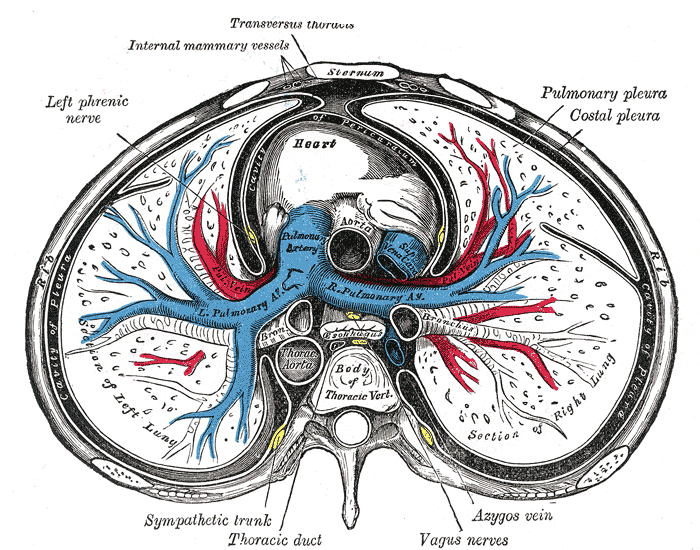Parietal pleura
| Parietal pleura | |
|---|---|
 | |
| A transverse section of the thorax, showing the contents of the middle and the posterior mediastinum. The pleural and pericardial cavities are exaggerated since normally there is no space between parietal and visceral pleura and between pericardium and heart. | |
| Latin | pleura parietalis |
| Gray's | subject #238 1087 |
| Nerve | intercostal nerves, phrenic nerves |
| Code | TH H3.05.03.0.00006 |
The portion of the pleura external to the pulmonary pleura lines the inner surface of the chest wall, covers the diaphragm, and is reflected over the structures occupying the middle of the thorax; this portion is termed the parietal pleura.
The parietal pleura is attached to the wall of the thoracic cavity and innervated by the intercostal nerves and phrenic nerve.
Parietal pleura lines the thoracic wall, covers the superior surface of the diaphragm and separates the pleural cavity from the mediastinum. The costal portion of the parietal pleura lines the inner aspect of the ribs and intervening intercostal muscles, being separated from them by endothoracic fascia. This part of the parietal pleura is innervated by the intercostal nerves. The diaphragmatic portion of the parietal pleura overlies the diaphragm and is innervated by the phrenic nerve in its central portion and by the intercostal nerves in its peripheral portion. The mediastinal portion of the parietal pleura forms the lateral wall of the mediastinum and is innervated by the phrenic nerve.
Additional Images
-
Visceral and parietal pleura. Deep dissection. Anterior view.
External links
- -1288372165 at GPnotebook
- thoraxlesson2 at The Anatomy Lesson by Wesley Norman (Georgetown University)
- lung_pleura at the University of Michigan Health System - "X-ray, chest, posteroanterior view"
- lung_lymph at the University of Michigan Health System - "Transverse section through lung"
- MedEd at Loyola Grossanatomy/thorax0/thor_lec/thor6.html
- Diagram at kent.edu
This article incorporates text from a public domain edition of Gray's Anatomy.
| ||||||||||||||||||||||||||||
